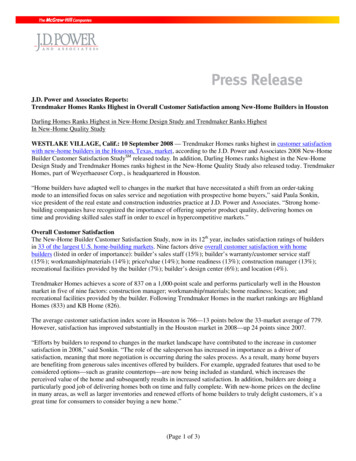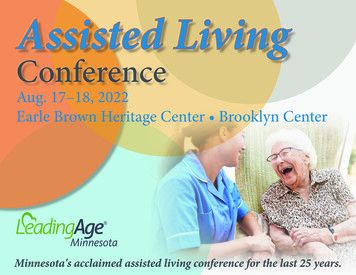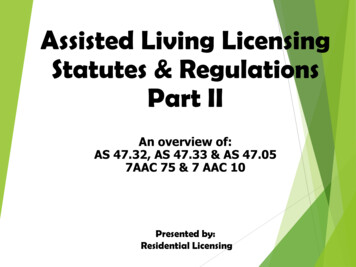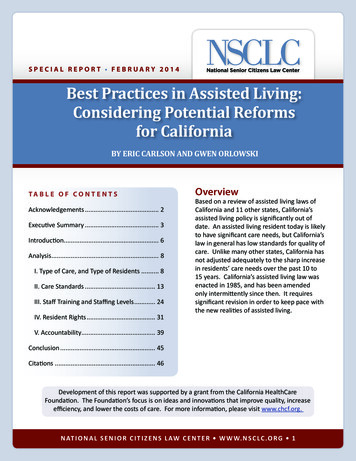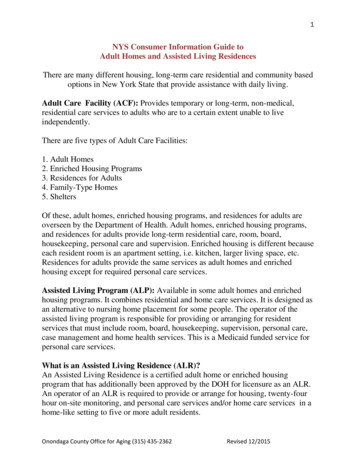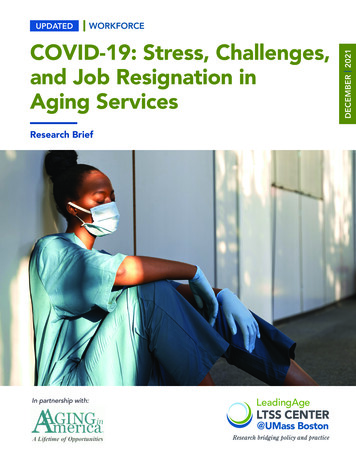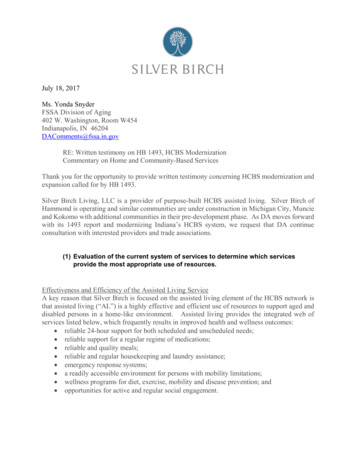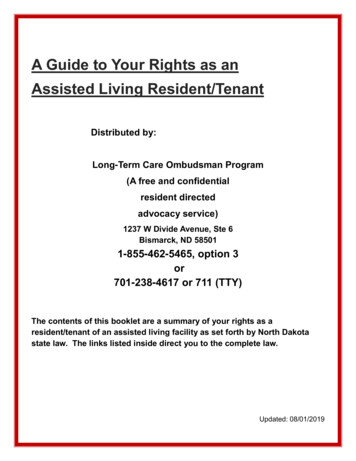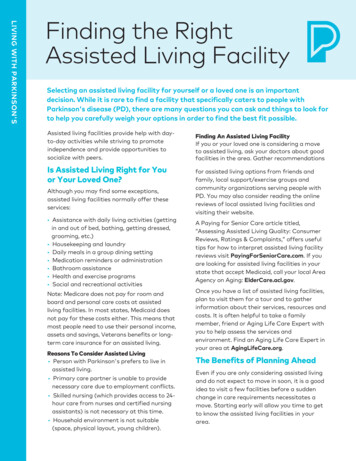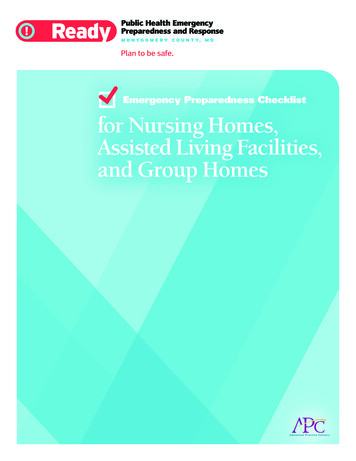
Transcription
Emergency Preparedness Checklistfor Nursing Homes,Assisted Living Facilities,and Group Homes
Emergency Preparedness ChecklistFacility administratorscomment on thechecklist andbroader emergencyeducation efforts:“We’re so luckyto be living inMontgomeryCounty .We feelcared about.”—Chandra Kumar,Administrator, MaplewoodPark Place CCRC, Bethesda“We appreciate notbeing forgottenor overlooked inthe emergencyplanning.”—Michelle Kraus,Administrator, MarinerHealth Care, Silver SpringOther comments offeredduring site visits:“We appreciate all of thegood ideas.”“Thank you for bringingsome areas we needto improve on to ourattention.”“We put our plan intoplace and it workedvery well during thehurricane.”“After the hurricane, wecan see some areas weneed to improve on,but basically, it wasbusiness as usual.”GOALS AND USESThe Montgomery County Advanced Practice Center for Public Health Emergency Preparednessand Response is pleased to provide public health professionals with this EmergencyPreparedness Checklist. The checklist is designed to ensure that health care facilities are notonly well prepared but also able to shelter-in-place and remain self-sufficient during a variety ofemergencies. It has proven to be a useful tool in: Emergency preparedness training, planning, and assessment Annual quality-of-care surveys Follow-up inquiries and consultation Efforts to contact facility administrators during actual emergenciesAlthough licensing and quality standards vary by jurisdiction, public health professionals and local,state, and federal regulators can view the checklist as a template that is readily adaptable to theirneeds and uses.BACKGROUNDPublic Health Services ofthe Montgomery County,Maryland Departmentof Health and HumanServices developed thevoluntary checklist as part of a broader planning and education effort in the wake of theSeptember 11, 2001 attack on the nearbyPentagon and subsequent anthrax and sniperscares in the region. Of particular concern wasthe likelihood that further emergencies mightleave local hospital emergency rooms unnecessarily inundated with residents from nursinghomes and other care facilities. Public HealthServices’s Licensure and Regulatory Servicesstaff assembled a Disaster Planning Workgroup of nurses, environmental health inspectors, a social worker, a program manager, anadministrative specialist, and facility ombudsmen. The Workgroup presented four trainingworkshops on emergency preparedness for administrators and key staff of nursing homes,assisted living facilities, and group homes forminors, the elderly, the chronically mentallyill, and the developmentally disabled. TheWorkgroup developed the Emergency Preparedness Checklist to assess the effectivenessof the training and identify topics for furthereducation and assistance.EFFECTIVENESSWithin a year of the training workshops, allskilled nursing homes and large assisted livingfacilities in the county had reviewed and up-dated their emergency plans to include sheltering-in-place. Several facilities had replacedtheir generators with more powerful models.Although not required by law to have a generator, all but one of the large assisted livingfacilities had acquired one. A severe storm andlater Hurricane Isabel in late summer 2003put the new systems to the test. With the contact information generated by the checklist,Licensure and Regulatory staff succeeded inreaching almost every facility (about 400) bytelephone before the hurricane and found thatmany were putting their emergency plans intoplace. Routine calls for emergency transportdid occur, and additional follow-up has shownthat some facilities still need to purchase aNOAA (National Oceanic and AtmosphericAdministration) weather radio and establishadequate water supplies for three days’ selfsufficiency.Licensure and Regulatory Services has incorporated the checklist into its annual qualityof-care surveys of nursing homes and largeassisted living facilities. The checklist enablesthe surveyor to assess each facility’s level ofpreparedness and helps reinforce the trainingworkshops. Surveyors believe the ongoingsurveillance and reinforcement are especiallyimportant because of turnover in facility leadership. Moreover, since each facility receivesa copy of the checklist, it also serves as abaseline and reminder for the administratorsin their efforts to develop and enhance theirorganization’s preparedness.
Emergency Preparedness Checklistfor Nursing Homes, Assisted LivingFacilities, and Group HomesF A C I L I T Y I N F O R M AT I O NA S S E S S M E N T I N F O R M AT I O NFacility nameDateAddressCompleted byPhoneTitleSignaturePREPAREDNESS CRITERIAFacility1Does the facility have a plan toshelter-in-place? Yes No In progress. Status:2Is the building secure beforeand after visiting hours? Yes No In progress. Status:3Can the facility obtain extramedicines from its pharmacyprovider in an emergency(overnight and on weekends)? Yes No In progress. Status:4a Does the facility maintain a three- Yes Noto five-day supply of food and water(one gallon per person per day)?4b Who is the contractor forfood and water? In progress. Status: Yes No In progress. Status:NameAddressPhone5a Does the facility have emergencyoutlets in all residents’ roomsand critical common areas?Modified: June 2005
Emergency Preparedness ChecklistPage 2 of 5Facility (continued)5b If not, how does the facilityplan to provide illuminationin those rooms?6a Does the facility have anemergency generator? Yes No In progress. Status:6b If so, what fuel does thegenerator use?6c What systems will thegenerator power?6d How long will the fuel lastuntil it must be replenished?Amount of days6e Who is the fuel contractor?NameAddressPhone7a Does the facility have oxygentanks on the premises? Yes No 7b If so, of what type and howmany?Type7c Who is the oxygen contractor?NameIn progress. Status:NumberAddressPhone8Does the facility have a NOAAweather radio? Yes No In progress. Status:
Page 3 of 5Emergency Preparedness ChecklistSupplies9Has the facility identified and keptin working condition necessary toolsand equipment (flashlights, batteries,tarps, radios, cell phones, and fans)? Yes No In progress. Status:10 Does the facility provide alternativemeans for hand washing? Yes No In progress. Status:11 Does the facility maintain a reservesupply of linen? Yes No In progress. Status:13 Has the facility provided trainingor information on emergencypreparedness to its staff? Yes No In progress. Status:14 Has the facility provided trainingor information on emergencypreparedness to the residents’ families? Yes No In progress. Status:15 Does every shift have a staff membertrained to turn off the ventilationsystem? Yes No In progress. Status:12 How does the facility handle trash,soiled linen, and other waste material?TrainingCommunity Outreach16 Has the facility considered reaching out Yes Noto its neighbors as a source of assistanceduring a widespread emergency?17 Has the facility encouragedcollaboration with its neighbors byproving emergency preparednesstraining? In progress. Status: Yes No In progress. Status:Modified: June 2005
Emergency Preparedness ChecklistE M E R G E N C Y C O N TA C T I N F O R M AT I O NAfter-hours contact information for the county’s confidential databaseFacility’s AdministratorWorkCellHomeE-mailFacility’s Medical DirectorWorkCellHomeE-mailFacility’s Director of NursingWorkCellHomeE-mailFacility’s MaintenanceSupervisorWorkCellHomeE-mailFIELD NOTESPage 4 of 5
Emergency Preparedness ChecklistPage 5 of 5FIELD NOTESCompleted byTitleSignatureDateFOLLOW-UPCompleted byTitleSignatureDateModified: June 2005
In 2004 Public Health Services of the MontgomeryCounty, Maryland Department of Health and HumanServices became one of the first eleven public healthagencies in the nation to be recognized as Public HealthReady by the National Association of County and CityHealth Officials (NACCHO) and the Centers for DiseaseControl and Prevention (CDC) of the U.S. Departmentof Health and Human Services. The county is home toone of eight Advanced Practice Centers for Public HealthPreparedness (APCs) funded by NACCHO throughthe CDC. The Montgomery County APC developed theEmergency Preparedness Checklist in conjunction withthe county’s Licensure and Regulatory Services program.This publication was supported by CooperativeAgreement Number U50/CCU302718 from the CDC toNACCHO. Its contents are solely the responsibility of theAdvanced Practice Center for Public Health EmergencyPreparedness and Response of Montgomery County,Maryland, and do not necessarily represent the officialviews of the CDC or NACCHO.This publication is in the public domain. It may bereproduced in whole or in part by any individual ororganization without permission, as long as the followingcitation is given: Montgomery County, MarylandAdvanced Practice Center for Public Health EmergencyPreparedness and Response, “Emergency PreparednessChecklist,” June 2005. If a part or all of the publicationis reproduced, the Montgomery County APC wouldappreciate knowing how it is used. Please use the form atour website, www.montgomerycountymd.gov/apcContact InformationMontgomery County Advanced Practice Centerfor Public Health Emergency Preparednessand ResponseContact Kay Aaby, RN, MPH, Program rycountymd.govWebsite www.montgomerycountymd.gov/apc
skilled nursing homes and large assisted living facilities in the county had reviewed and up-dated their emergency plans to include shel-tering-in-place. Several facilities had replaced their generators with more powerful models. Although not required by law to have a gen-erator, all but one of the large assisted living facilities had acquired one.
